1) 1911 Gold Corp - History, Overview, Projects, R
Post# of 392
====================
1911 Gold Corp - History
====================
In January 2016, the Nevada based mining company Klondex Mines acquired Truth North Mine Complex in Manitoba:
https://www.globenewswire.com/news-release/20...mplex.html
In August 2017 Klondex Mines acquired Bison Gold for US$9 million. Bison owned the Ogama-Rockland Mine and Central Manitoba Mine located at southeast of True North Mine Complex.
In March 2018 Klondex Mines was acquired by Hecla Mining for US$462 million. Hecla Mining (HL.NYSE) is a silver producer based in Idaho, it produces more than 45 percent of all silver in the United States and has operating mines in Alaska, Idaho, Quebec and Yukon.
During the acquisition, Klondex Mines spun the Canadian assets into a new entity, Klondex Canada which was incorporated as Havilah Mining on May 3, 2018 in the Toronto Stock Venture Exchange:
https://www.1911gold.com/news/press-releases/...-mines-ltd
On June 24, 2019 Havilah Mining changed name to 1911 Gold Corp to better fit its heritage value. The administrative office is located in Vancouver. Its stock is listed publicly on the TSX Venture Exchange under the symbol “AUMB”, on the OTCQX market under the symbol “AUMBF” and in Germany under the symbol "2KY.FRA".
======================
1911 Gold Corp - Overview
======================
1911 Gold Corporation is engaged in the acquisition, exploration, development and extraction of precious metals. The Company owns and operates the Rice Lake property which holds the True North gold mine and mill as well as the Apex property near Snow Lake, Manitoba and the Denton-Keefer properties near Timmins, Ontario. The True North mine is located in the heart of the world-class Rice Lake gold district within the West Uchi greenstone belt. The Company holds a dominant land position with over 63,000 Hectares (630 square kilometer), an operating milling facility, an underground mine with one million ounces gold resources, and significant upside surface exploration potential.
1911 Gold Corporation is committed to operating and developing projects to the highest standard of responsibility, sustainability and respect for the environment, and the communities we work in. Our corporate values, experienced management team and forward thinking board of directors are committed to maximizing shareholder value through transformational growth, and strategic partnership creation.
In conjunction with the 5 hectares (50,000 square meters) True North mill complex, the 58,000 hectares (580 square kilometer) exploration properties surrounding the complex cover the most prospective portions of the Rice Lake greenstone belt, part of the same belt of greenstones that includes the world-class, high-grade Red Lake gold district, located approximately 100 km to the east in Ontario.
https://www.google.ca/maps/place/Rice+Lake/@5...FQAw%3D%3D
https://investorshangout.com/images/MYImages/...wFault.jpg
https://investorshangout.com/images/MYImages/...ojects.jpg
The Rice Lake belt is bound to the north along much of its length by the crustal-scale Wanipigow Fault that extends to Red Lake and is considered to represent a first-order control on gold mineralization, comparable in scale to the Porcupine-Destor Fault in the world-class Timmins-Porcupine Gold Camp.
Although the Rice Lake belt has been explored for gold since its discovery in 1911, previous efforts at systematic belt-scale exploration were hindered by a highly fragmented land position. In this regard, the Company's consolidated land position, the largest ever assembled in the belt, represents an unprecedented opportunity to evaluate this under-explored district at belt-scale, utilizing modern exploration methods.
The consolidation of the Rice Lake district took place in stages between 2011 and 2017 through acquisitions by precursor companies, culminating in 2019 with the acquisition through ground staking of an additional 11,382 hectares (113.82 square kilometers) of highly-prospective ground over the western and northeast portions of the Rice Lake greenstone belt, adjacent to the Wanipigow Fault.
As one of 1911 Gold's flagship assets, the True North Complex is a key component of the overall corporate strategy to develop a district-scale gold exploration and mining operation around a centralized ore processing facility in the Rice Lake greenstone belt.
The Rice Lake exploration properties 150 Km northeast of Winnipeg are easily accessed year-round via provincial road 304 and 314 which service the communities of Manigotagan and Bissett and provides ready access for cost-effective exploration. They include two large highly-prospective claim blocks referred to as Rice Lake and Central Manitoba, both 100% owned by the Company and both include significant past-producing mines. The 43,895 hectares Rice Lake property consists of a continuous block of mining claims and mineral leases in the western and north-central portions of the belt. It extends for 80 km along the Wanipigow Fault and includes the True North mine with 2 million ounces of historical gold production. The 9,227 hectares Central Manitoba property covers the prospective eastern portion of the Rice Lake belt 25 km southeast of the True North Complex. The geological setting is analogous to True North and includes the historical Central Manitoba, Gunnar and Ogama-Rockland mines which account for 300,000 ounces of past gold production. 2022 drilling confirms the extensions of gold mineralized structures over 400 meters of strike length on the Wentworth vein corridor and over 270 meters of strike length on the Hope-Roger vein corridor at the historical Central Manitoba Gold Mine.
1911 Gold's ore processing mill
Located on the north shore of Rice Lake in Manitoba, 150 Km northeast of Winnipeg, the 50,000 square meter True North Complex is a modern, fully-permitted 1,300 tonnes per day ore processing facility, expandable to 2,500 tonnes per day, tailings management area and reprocessing operation, underground mine infrastructure (currently under temporary closure), and the True North Gold Deposit. The Company is successfully generating near term cashflow from historic tailings, producing between 5,000 and 5,500 ounces of gold a year to support the exploration effort and maintain the existing facilities.
Under the guidance of a strong technical management team with exceptional local knowledge, the Company is actively exploring in areas of the Rice Lake belt that have historically seen little to no activity. The successful exploration results to date have provided further conviction that the discoveries in the region have only just begun.
Existing infrastructure at True North, combined with the high-grade mineral resource, provides a solid foundation to build a modern long-life mining and processing operation. The site has necessary infrastructure to maintain operations: All-season road access, grid hydroelectric power and broadband communications, as well as on-site maintenance shops, assay laboratory, warehouse, fuel storage facilities and administrative offices. There is a 200-room camp with kitchen, dining, recreation and fitness facilities.
https://www.google.ca/maps/place/Rice+Lake/@5...FQAw%3D%3D
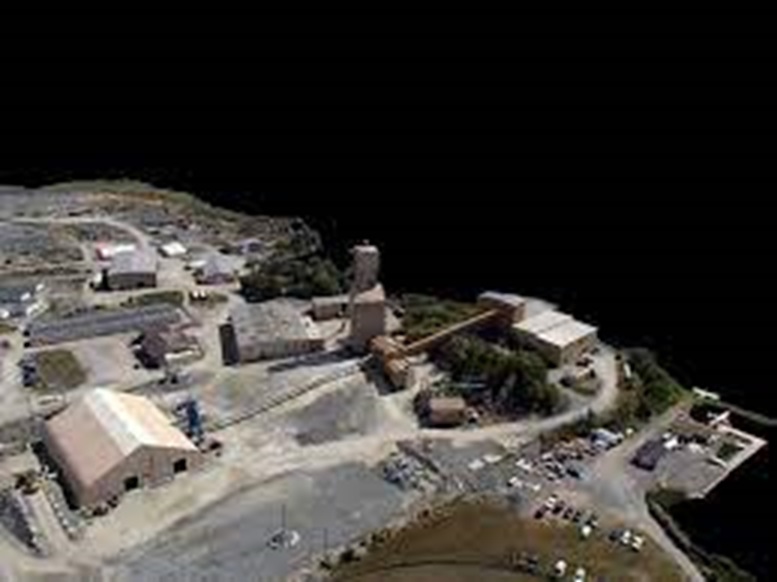
https://investorshangout.com/images/MYImages/...gplant.jpg
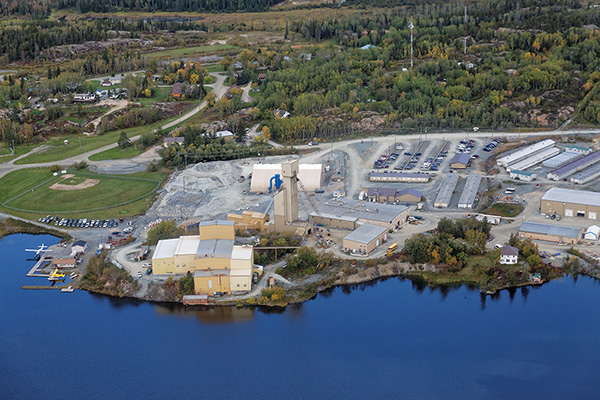
https://investorshangout.com/images/MYImages/...lity_1.jpg
~~~~~~~~~~~~~~~~~~~~~~~~~~~~~~~~~~~~~~~~~~~~~~~~~~~~~~~~~
============================
1911 Gold - Projects and Resources
============================
The Company owns over 63,000 Hectares (630 square kilometer) of land with significant gold resource potential, an ore processing mill with 1,300 tonnes to 2,500 tonnes per day throughput capacity, underground mines and accretive gold resources currently at 1.143 million ounces of gold.
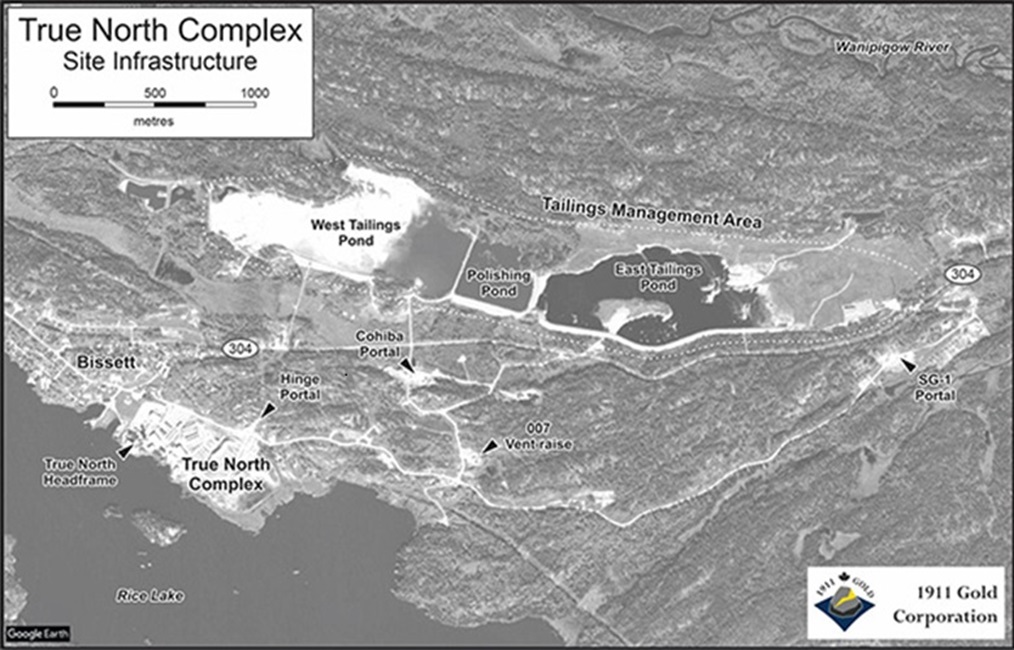
https://investorshangout.com/images/MYImages/...cility.jpg
Projects with gold grades
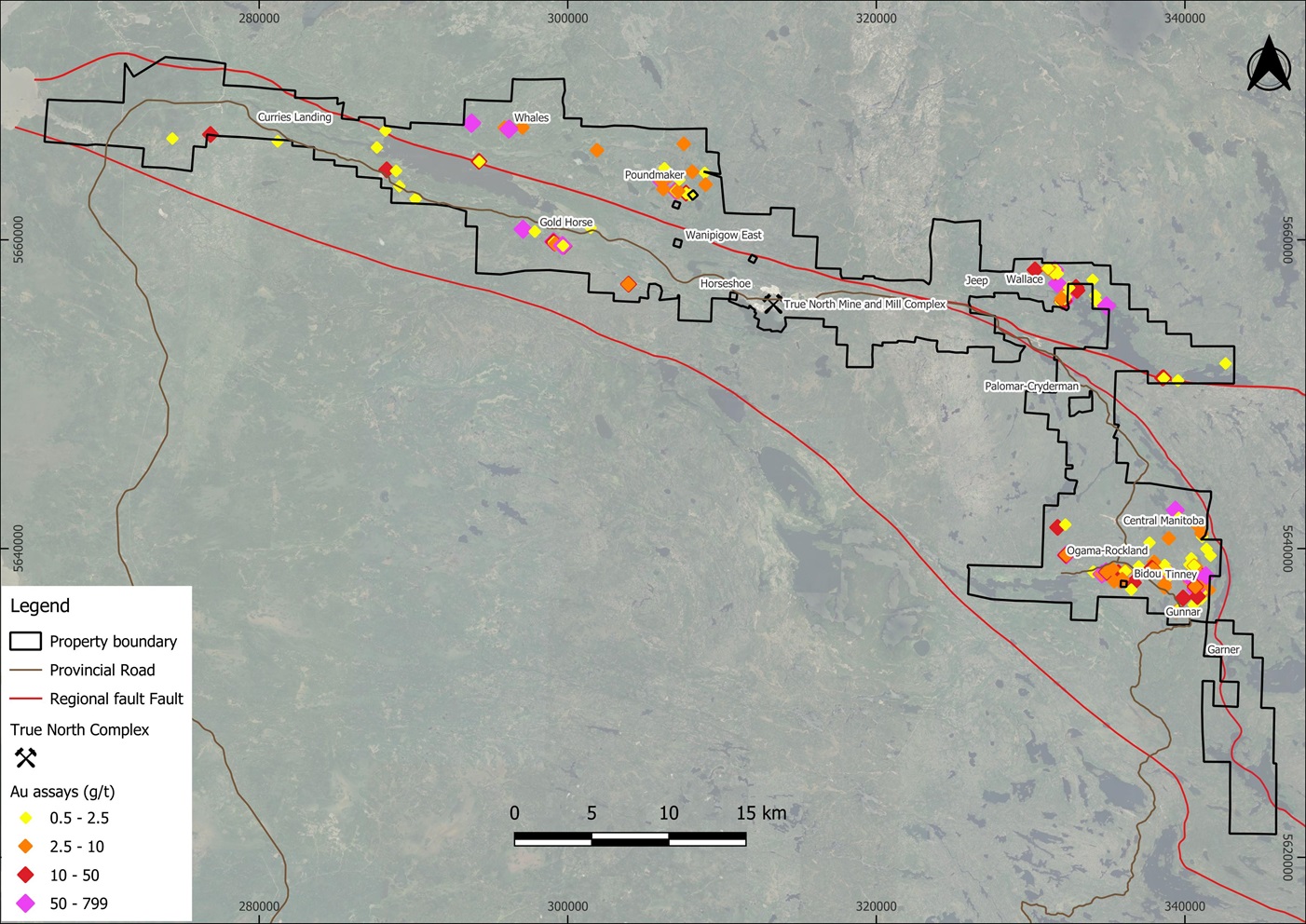
https://investorshangout.com/images/MYImages/...thgold.jpg
==============
True North region
==============
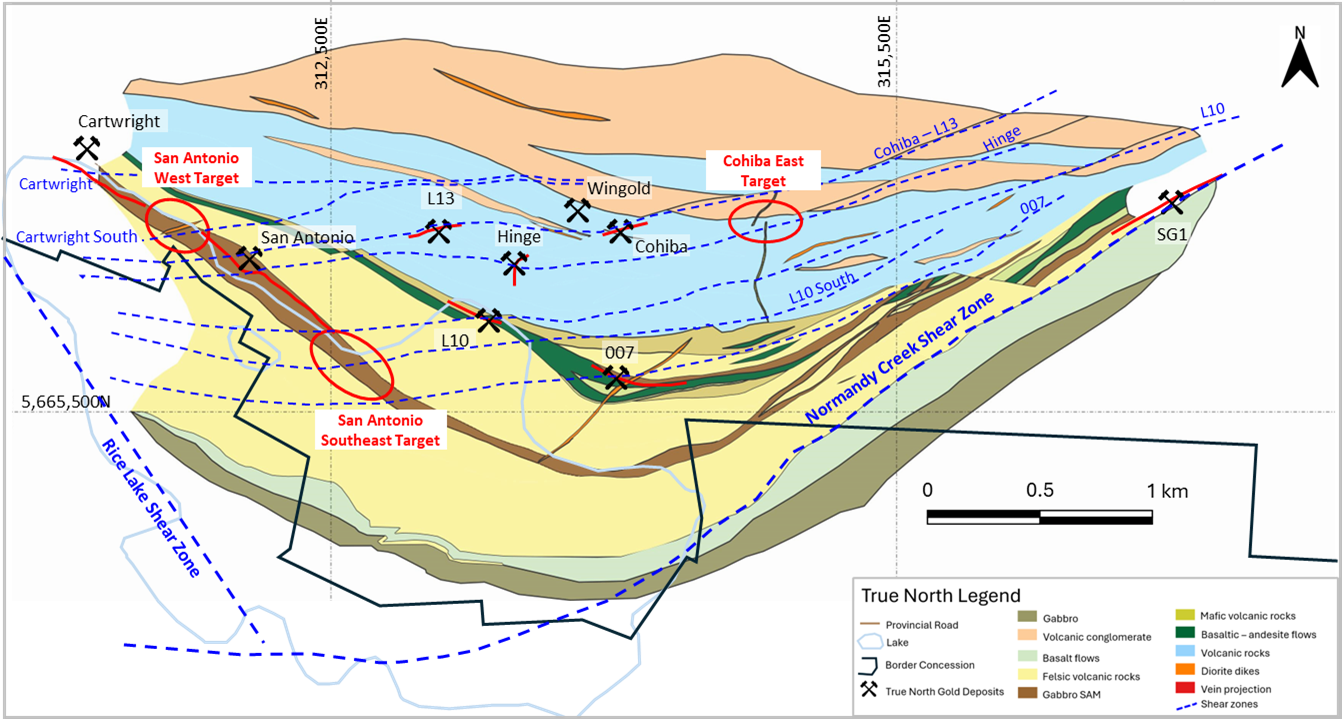
https://investorshangout.com/images/MYImages/...gareas.png
Three mines: True North Mine, Hinge Mine and Cohiba Mine, often referred to as the Truth North Mine Complex, host super high grade gold. There are underground ramps connecting to adjacent mines. The Truth North Mine Complex has produced over 2 million ounces of gold in the past.
*** True North Mine
True North Mine is a shaft mine with a headframe and is 1,600 meter (5248 feet) deep. Within the True North Mine there are significant vein structures stepping out from the main unit trending towards the east to L10 Mine and L13 Mine. .
*** Hinge Mine and Cohiba Mine
Both Hinge Mine and Cohiba Mine are ramp mines extending 800 meters and 400 meters below surface respectively. Within Hinge Mine there is a ramp to 007 Mine, the fourth mine, accessible only underground. Core from the Hinge zone returned spectacular grades including 207.1 g/t Au over 2.3 meters. During test mining, close to 6,000 oz of gold was recovered from the 10,700-tonne bulk sample. The numbers represent stopping grades of 12.7 g/t and development grades of 16.9 g/t. In the main Hinge lens No. 1, the grade was even better at 26.3 g/t Au. The total direct bulk sample operating cost was US$158 per ounce. The Hinge mining rate was about 300 tonnes/day.
Past news on assays in Truth North Mine Complex:
Nov 17, 2016 - Klondex Announces Updated Drill Results at True North; Drilling Supports Expansion of 710/711 and Cohiba Zones
https://www.resource-capital.ch/en/news/view/...iba-zones/
January 24, 2017 - Klondex Announces New Discovery at True North; Drilling Continues to Extend Known Mineralization
https://www.globenewswire.com/news-release/20...ation.html
July 26, 2017 - Klondex Announces High Grade Exploration Results at True North; Intercepts 5.78 opt Au over 3.7 ft (198.1 g/t over 1.1 m)
https://www.juniorminingnetwork.com/junior-mi...-mine.html
Assays from Truth North Mine Complex (2016 - 2017)
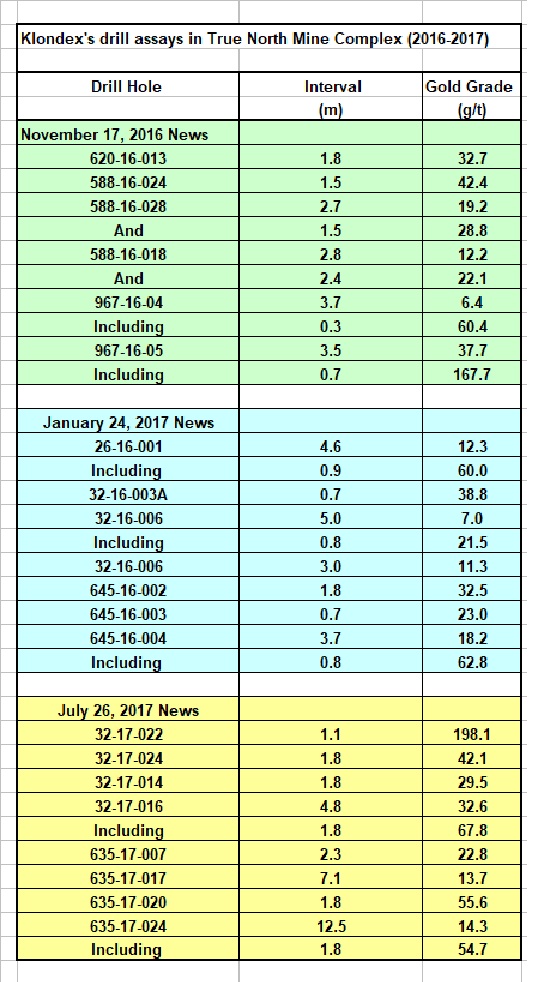
https://investorshangout.com/images/MYImages/...assays.jpg
==================
Central Manitoba region
==================
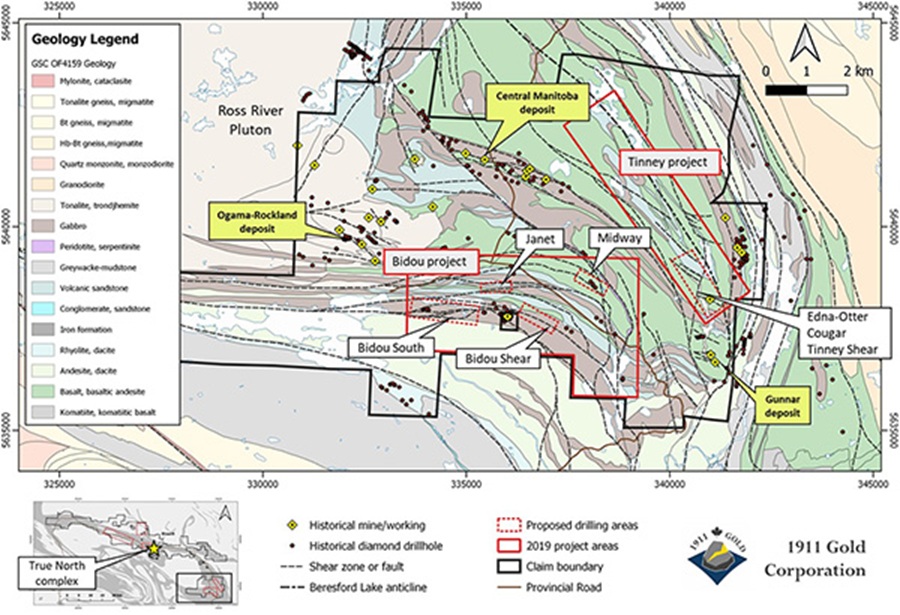
https://investorshangout.com/images/MYImages/...ig9-tn.jpg
Central Manitoba region is made up of 2 zones: Ogama-Rockland zone and the Central Manitoba zone. This region has produced 205,000 ounces of gold.
Ogama-Rockland Mine and Central Manitoba Mine were owned by Bison Gold which was acquired by Klondex in October 2017 for $9 million.
Ogama-Rockland Mine was discovered in 1915, mining activities occurred intermittently from 1942 to 1951. The mine relied on underground workings with a single shaft. The subsurface depth is 314 meters (1,030 feet), the ore extracted consists of pyrite, pyrrhotite, and molybdenite. Geologically, the Ogama-Rockland Mine is situated within an area characterized by diorite, a type of igneous rock formed in the Neoproterozoic era 100 million to 540 million years ago. The mine is currently closed.
Current resources estimate at Ogama-Rockland Mine is 337,000 ounces gold (1.28 million tonnes ores at gold grade of 8.17 g/t with cut off rate of 2.5 g/t). ( https://1911gold.com/news/press-releases/1911...north-mine )
Mining operations at Central Manitoba Mine were active from 1927 to 1937. The method of extraction used was underground mining, which involved creating tunnels and working underground. There is one shaft used to access the mine workings. The subsurface depth of the mine reaches 266 meters (873 feet).
Central Manitoba Mine is the second-largest mine in the Rice Lake district with total gold production of 160,000 ounces at 12.60 g/t. In 2009 Bison Gold drilled 66 diamond drill holes for a total of 13,268 meters to test the extensions of gold mineralization and confirmed the vein systems extend over 2.6 km at surface. 1911 Gold's 2022 drilling corroborated the extensions of gold mineralized structures over 400 meters of strike length on the Wentworth vein corridor and over 270 meters of strike length on the Hope-Roger vein corridor. ( https://1911gold.com/news/press-releases/1911...-gold-mine )
Bison Gold's historical news:
May 30, 2011 - New gold bearing zone is confirmed
https://uk.marketscreener.com/news/latest/QUE...-13646036/
June 13, 2013 - History of Central Manitoba projects
https://finance.yahoo.com/news/bison-gold-res...15908.html
Nov 18, 2013 - Bison Gold Announces Maiden High Grade Mineral Resource Estimate on the Ogama-Rockland Gold Deposit
https://finance.yahoo.com/news/bison-gold-res...00745.html
Bison Gold's assays in Central Manitoba region:
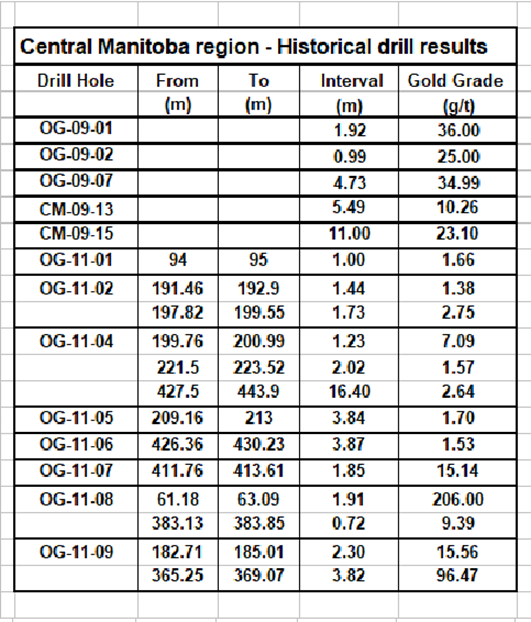
https://investorshangout.com/images/MYImages/...esults.png
=========================
Apex Gold Project in Snow Lake
=========================
Apex Gold project is another potential high-grade gold mine in dormant.
https://www.google.ca/maps/place/Snow+Lake,+M...FQAw%3D%3D
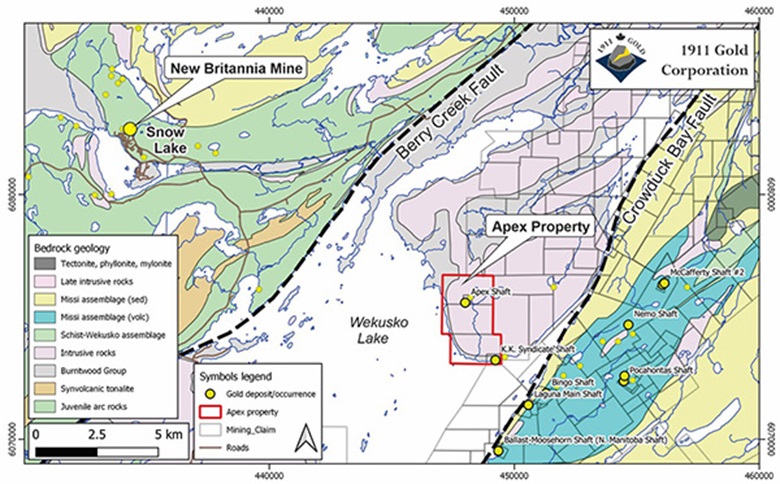
https://investorshangout.com/images/MYImages/...owLake.jpg
The Apex exploration property is located 15 kilometers southeast of the town of Snow Lake (570 kilometers north of Winnipeg) in north-central Manitoba and consists of 5 mining claims, totaling 752 hectares, that are 100% owned by the Company.
The Apex property is situated in the Proterozoic Flin Flon greenstone belt, one of the most prolific mining districts in the world, with world-class gold-rich volcanogenic massive sulphide (VMS) and orogenic gold deposits. The property has been explored intermittently dating back to the discovery of the Apex and KK showings in 1917–1918. It is situated in a favorable structural setting, within a fault-block bound on both sides by crustal-scale faults, and lies immediately north of the Laguna property being explored by an affiliate of Kinross Gold Corp. The New Britannia mine, located at Snow Lake, produced more than 1.4 million ounces of gold and includes a gold processing facility owned by Hudbay Minerals Inc.
Situated on the northeast shore of Wekusko Lake, the Apex property can be easily accessed by boat from a landing on provincial road 392, located 9 kilometers to the west.
1911 Gold Advances the Apex Gold Property near Snow Lake Manitoba; Grab Samples Return up to 1,240 Grams per Tonne Gold
https://www.1911gold.com/news/press-releases/...tonne-gold
====================
Ramp Mine vs Shaft Mine
====================
The main difference between ramp mines and shaft mines is that ramps are tunnels that descend from the surface, while shafts are vertical openings:
Ramps, also known as declines, are tunnels that are driven downward from the surface to transport materials, waste, ore, and personnel. Ramps can also be used to connect different levels within an underground mine. Ramps are a good option when there is a lot of vegetation on the surface that you don't want to clear.
Shafts are vertical or near-vertical tunnels that are sunk into the ground to access an underground ore body. Shafts can be used for a variety of purposes, including:
Moving people, materials, and mine services
Ventilation air
Removing broken rock, such as ore or waste
Providing an escape route in an emergency
https://investorshangout.com/1911-Gold-Corp-AUMBF-94051/
 (0)
(0) (0)
(0)